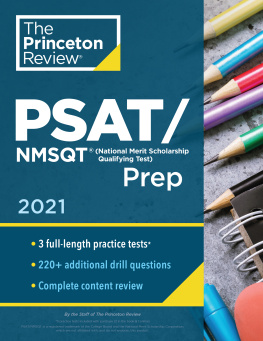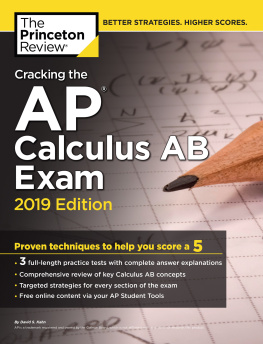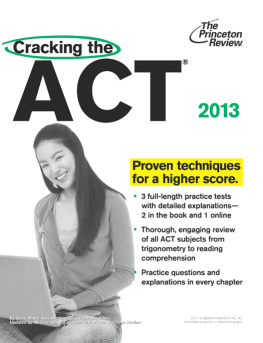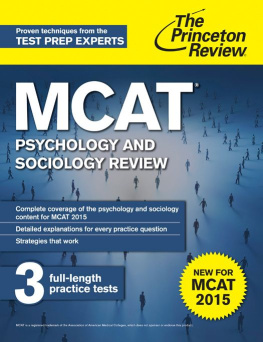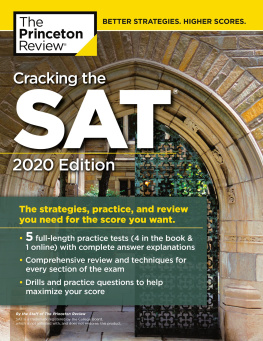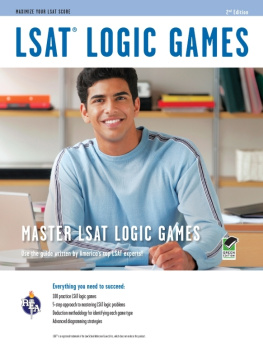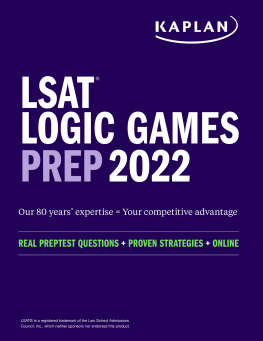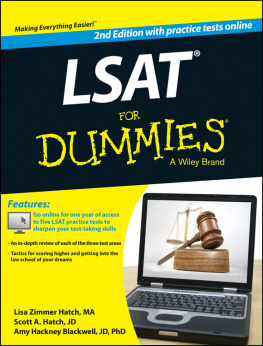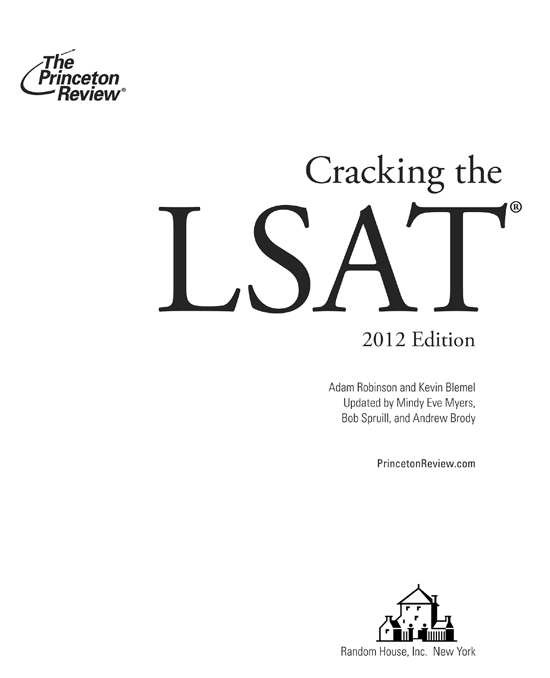
Editorial
Robert Franek, VP Test Prep Books, Publisher
Seamus Mullarkey, Editorial Director
Laura Braswell, Senior Editor
Heather Brady, Editor
Selena Coppock, Editor
Random House Publishing Team
Tom Russell, Publisher
Nicole Benhabib, Publishing Manager
Ellen L. Reed, Production Manager
Alison Stoltzfus, Associate Managing Editor
The Princeton Review, Inc.
111 Speen Street, Suite 550
Framingham, MA 01701
E-mail:
Copyright 2011 by The Princeton Review, Inc.
Cover design 2011 by Random House, Inc. Cover art Nicholas Monu/iStock Photo.
The Princeton Review is not affiliated with Princeton University.
All rights reserved. Published in the United States by Random House, Inc., New York, and in Canada by Random House of Canada Limited, Toronto. Originally published by Villard Books, a division of Random House, Inc., 1989.
Terms of Service: The Princeton Review Online Companion Tools (Online Companion Tools) for the Cracking book series and 11 Practice Tests for the SAT & PSAT are available for the two most recent editions of each book title. Online Companion Tools may be activated only once per eligible book purchased. Activation of Online Companion Tools more than once per book is in direct violation of these Terms of Service and may result in discontinuation of access to Online Companion Tools services.
LSAT directions copyright 1989 Law School Admission Council, Inc. All rights reserved. Reprinted by permission of Law School Admission Council, Inc.
Permission has been granted to reprint portions of the following:
The Export of Hazardous Wastes: Issues and Policy Implications, by C. E. Davis and J. D. Hagen, taken from International Journal of Public Affairs, Vol. 8, No. 4, 1986.
Employee Drug-Testing Issues Facing Private Sector Employees, by Steven O. Todd, taken from North Carolina Law Review, Vol. 65, No. 4, 1987.
The Right of Publicity Revisited: Reconciling Fame, Fortune and Constitutional Rights, by Jane Gross, taken from Boston University Law Review, Vol. 62, No. 4, 1982.
An Economists Perspective on the Theory of the Firm, by Oliver Hart, 89 Columbia Law Review 1957. 1989 by the Directors of the Columbia Law Review Association, Inc. All rights reserved. Used by kind permission from Professor Hart and Columbia Law Review. Several minor editorial changes were made to make the excerpts conform to LSAT passage specifications.
Mr. Hart is a professor of economics at M.I.T.
eISBN: 978-0-375-42766-4
Editor: Laura Braswell
Production Editor: Kathy G. Carter
Production Coordinator: Deborah A. Silvestrini
v3.1
Acknowledgments
A successful LSAT program is a collaborative effort. Wed especially like to thank Andrew Brody, Akhil Sheth, and Jennifer Wooddell for their expertise.
A very special thanks to Oliver Hart, professor of economics at M.I.T., and to Debora Davies and the folks at Columbia Law Review for their generous permission to quote an excerpt from an article by Professor Hart.
Finally, wed like to thank all those who have taught us everything we know about taking testsour students.
Special thanks to Adam Robinson, who conceived of and perfected the Joe Bloggs approach to standardized tests and many of the other successful techniques used by The Princeton Review.
Contents
Foreword
Dear Prospective Law Student:
Congratulations on your decision to purchase The Princeton Reviews Cracking the LSAT. This self-study guide will help you achieve your highest possible score on the LSATarguably the most significant single factor in law school admissions decisions.
While most applicants understand the importance that the LSAT plays in their law school applications, many are unaware that the score they receive can have far-reaching consequencesoften determining much more than just which law school they will attend. For example, many law schools consider LSAT scores when awarding merit scholarships and grants. Given that the average full-time Juris Doctor degree costs more than $150,000, a high score on the LSAT may well translate into tens of thousands of dollars in financial aid that can significantly reduce your law school debt upon graduation.
The LSAT purports to gauge your reading comprehension, reasoning, and analytical skills in an effort to predict your ability to survive a demanding law school curriculum. Those who hone their LSAT test-taking skills usually score the highest. Indeed, a strong LSAT score can be as much an indication of a strong work ethic as it is of intellect.
So invest the time and master The Princeton Reviews proven test-taking strategies. While that investment begins with Cracking the LSAT, it should not end there. To get the most out of your self-study, take advantage of the many resources that accompany this book. By registering your book at PrincetonReview.com/cracking, you can gain access to additional practice tests, personalized score reports, online exercises, tutorials, and more.
The Princeton Reviews master instructors are devoted to sharing their wisdom and inspiration so that you can conquer the LSAT. Cracking the LSAT and its online supplement are the fruits of their efforts. I firmly believe that The Princeton Review, with its personalized instruction and test-taking techniques, is the very best way for you to prepare comprehensively for the LSAT.
Good luck!
Sincerely,
Donald W. Macaulay, Esq.
President and Founder, Law Preview
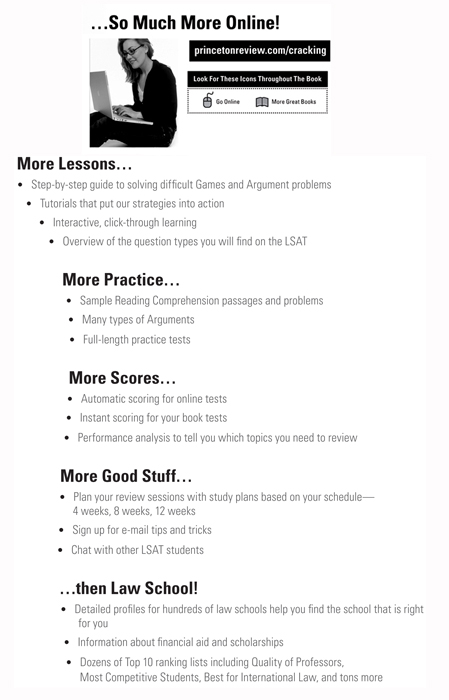
Chapter 1
General Information and Strategies
In this chapter, were going to give you an overall preparation plan for the LSAT. Before we hit you with some test-taking techniques, we want to make sure that you know all that we know about the LSAT itself. Well start with a few pages worth of information on the test. Make sure you read all this info carefully so youll know exactly what youre up against.
CRACKING THE LAW SCHOOL ADMISSION TEST
We hope youve bought this book at least a few months before the date of the LSAT you plan to take, so youll have time to (a) actually follow the suggestions we make, including working on actual LSAT tests released by the Law School Admission Council (LSAC); (b) work through the specific problems in (at least twice); and (c) complete both practice tests at the end of this book.
If youve bought this book only a few weeks before the LSAT, read through this chapter and absorb the test-taking tips that we give you; then work through . Finally, try to take at least one of the tests in the back of the book.
If youve bought (or are merely opening) this book for the first time only a few days before the LSAT, well, we admire your bravado. Take a complete test to see approximately what you would score on a real LSAT. If its more than five or six points below where you want to be, consider skipping the test and taking it at a later date. The best way to improve your score dramatically is to work steadily on hundreds of problems throughout the course of a few months. Remember: The title of this book is


